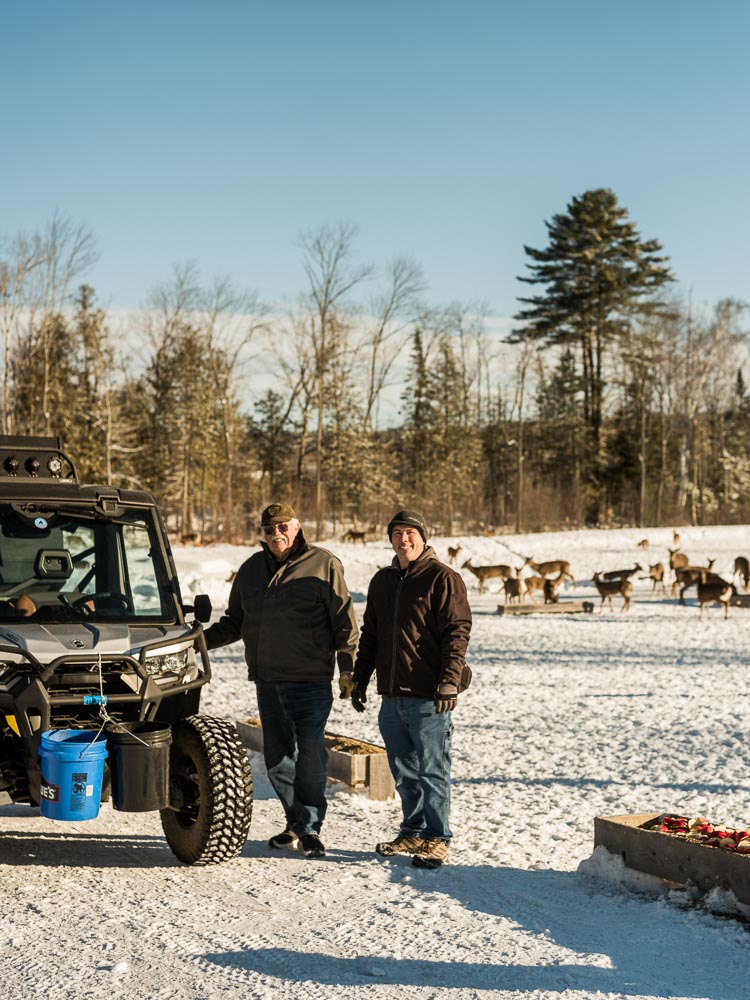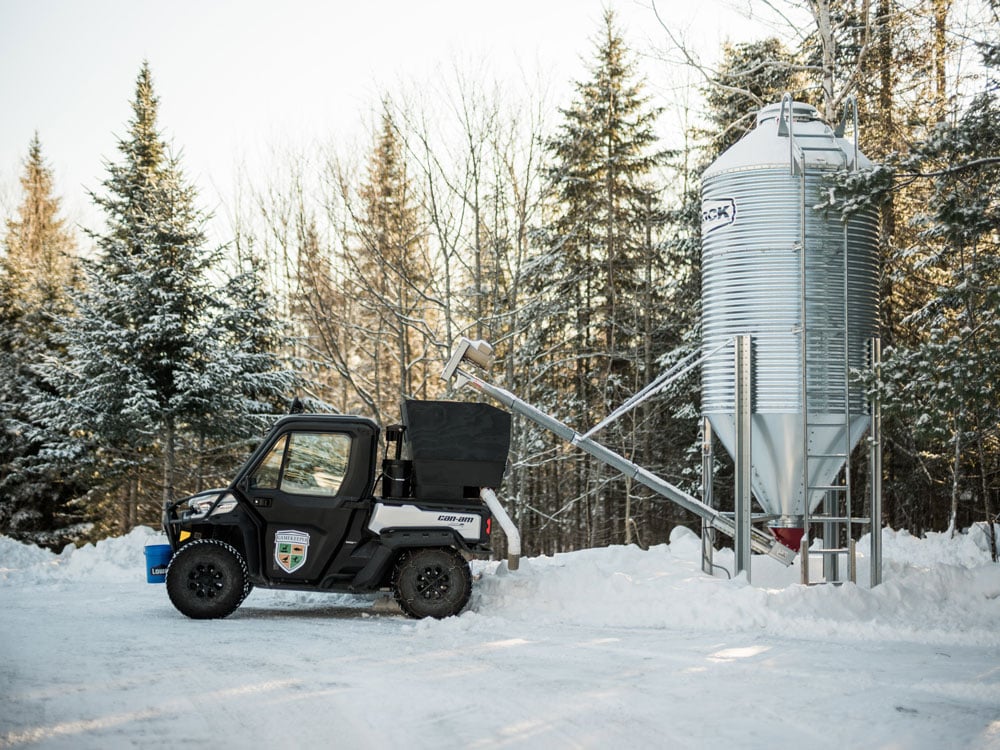By Nora Saks
Photos by Dave Waddell
From our April 2023 Animals issue
The sun is still groggy as some 212 white-tailed deer start milling around Richard McMahon’s backyard. It’s January, the middle of a cold snap, and they’re hungry. Lucky for them, Brownville’s Food Pantry for Deer is about to open for business. Just before 9 a.m., Richard and I climb into “the Oatmobile,” a tricked-out four-wheeler with a hopper on the back, which he tops off with roughly 1,000 pounds of oats from his miniature silo. Then, we rumble down the hill to greet the herd.
With the press of a button from inside the heated cab, oats stream into the first of eight troughs arranged in a tidy semicircle. Richard’s son Randy trails behind us, emptying buckets of sliced apples, foraged acorns, and deer feed. Before we’re at the next trough, the boldest of the ungulates wander over to the smorgasbord and dive in. The wild deer might arrive hungry, Richard says, “but they leave fat and sassy.”
Richard is 76 and has loved the “gentle souls of the forest,” as he calls them, ever since he was a boy feeding them peanuts out of his palm at a game farm in New York. Something about that close interaction just stuck with him. And so he’s fed these creatures everywhere he’s lived, which for the last 50-plus years has been this woodsy corner of Piscataquis County. Brownville winters can be rugged, and Richard worries that without a helping human hand, the deer might not survive. He grew up on venison. He hunted. And over the decades, he says, he’s watched the local whitetail population dwindle. “Now, I feed them instead of them feeding me,” he says. “I just enjoy the shit out of it.”
The retired contractor performs this labor of love about 100 days a year, from December 16 through early April, during the nearly six-month window when it’s legal to feed wild deer in Maine. This season, he expects to distribute 37 tons of oats and hundreds of bushels of apples.



Once the hopper is empty and crunching sounds fill the air, we head inside for a cup of chaga tea. On our way up to the house, I get a text: “We could hear you guys talking! You look great in the Oatmobile!” I realize that, down in Smithfield, my boyfriend and his mom are watching us live on YouTube, along with roughly 2,000 other people all across the world.
Feeding wild deer is easy, but it isn’t cheap, especially on this scale, and five years ago, Richard had an idea to help him cover costs: install a few game cams and stream the feed. At last tally, Brownville’s Food Pantry for Deer had almost 128,000 YouTube subscribers and more than 57,000 Facebook followers, with wildlife lovers from 158 countries tuning in to “trough view,” “close view,” “road view,” and “Richard’s PTZ” (that’s “pan, tilt, and zoom”). The McMahons never imagined it would be such a hit — or so much work. Richard’s girlfriend, Belinda, spends hours each day online, responding to messages and queries and sending thank-you cards to everyone who makes a donation.
Skim the pantry’s chats and comment threads and you’ll read, over and over again, “thank you,” “great job,” and “God bless.” Also variations on, “Me and the wife watch it every morning and every night.” The word “obsessed” appears frequently — as in, “Am I obsessed if I have 2 computers n 3 tablets streaming the deer n bird feeder 24/7?”
At first, I didn’t get the obsession. But then I too found myself regularly opening up YouTube and checking in on the gentle souls of the forest. Watching the bucks and does amble in and out, getting oats stuck to their muzzles, lowered my anxiety. When I reached out to some of the pantry’s online following, I got the sense that Richard is providing sustenance to more than just a herd of Maine deer.
I discovered that Patti, in Illinois, has agoraphobia, and that watching the deer feeding helps her de-stress. Kenneth, a trucker, turns it on during chemotherapy. Marilyn, who has a panic disorder, finds the deer calm her down. Denise claims it’s a godsend for insomniacs. Sergey, a disabled pensioner in Russia, writes that watching the animals gives him peace of mind. For Dahlma, in San Diego, the whimsical winter scene transports her back to her childhood in Hungary, where her family watches now too. And when Toni tunes in, she’s reminded of her dear friend Barb, who passed away. “She didn’t get to see the start of the cameras with me this year,” Toni wrote, “but she had a much better view than I did from up above.”
I started to understand why the livestream is played on TVs in schools, nursing homes, and hospitals, why teachers and nurses say it has a therapeutic effect. Then, I spoke to Elias. He’s 17 and lives in a medieval mountain town in Austria. He and his mom stumbled on the deer pantry while looking for cat videos during the pandemic. Now, they tune in a few times a day. When we spoke, he put words to something that I, and I think a lot of other viewers, have felt. “You know, the world is so uncertain at the moment, with inflation and all the conflicts,” Elias said. “Watching the deer gives me a sense of security. It represents an always-okay world.”

Officially, the Department of Inland Fisheries & Wildlife has a neutral stance towards feeding wild deer. The state will advise on best practices but doesn’t encourage it. Deer live off their body fat during the winter, DIFW biologist Nathan Bieber says. “It’s just how they do it. If you give them food, they’ll eat it because it’s food and it’s in their face. But they don’t need it in most of Maine. They really don’t.” Still, if a resident insists on feeding wild deer, he says, it’s important to think about the long term. Once you start, you can’t really stop. You don’t want to pull the rug out from under them.
Halfway into their 14th season, Richard and Randy were already talking about the future. Next year, they want to upgrade the Oatmobile to a pickup truck, to haul even more oats. One day, they hope to establish a permanent nature preserve. And should a season arrive when his father can no longer make the feeding rounds, 39-year-old Randy plans to keep the pantry going strong. Not that Richard’s commitment is wavering. “The way I feel now,” he says, “I’m good to go for at least another ten.”




